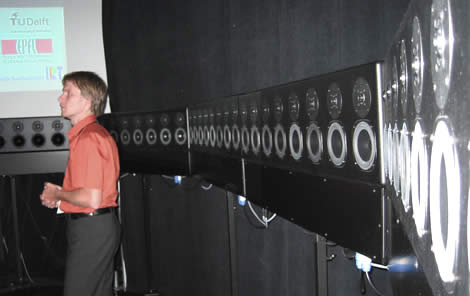Denon Electronics has announced the D-M71DVXP, a DVD receiver system that is the world’s first audio/video product to incorporate Dolby Virtual Speaker surround sound technology.
The new system consists of an integrated DVD/receiver unit, two satellite speakers, and a subwoofer. The Dolby Virtual Speaker technology, which uses core algorithms developed by Australian OEM developer Lake Technology, will produce a realistic 5.1-channel surround listening experience from the 2-speaker-plus-sub set-up that Denon and Dolby Labs representatives say is far superior to any previously available virtual surround process.
The Denon D-M71DVXP DVD Receiver System will be available in September 2003, with a suggested retail price of $999 (US). In addition, a two-channel version without the subwoofer will be available for $699 (US).
“Denon’s philosophy has always been to utilize the most advanced audio and video technologies to deliver the best home entertainment experience to our customers,” says Stephen Baker, Denon senior VP of sales and marketing. “Thanks to Dolby Virtual Speaker, our D-M71DVXP delivers a level of sonic performance that would simply not be possible otherwise.”
The D-M71DVXP uses the same advanced Analog Devices Hammerhead SHARC 32-bit DSP audio processors used in Denon’s acclaimed AVR-5803 and AVR-3803 audio/video receivers.
Speaking for Dolby Laboratories, the company’s director of consumer technology marketing Craig Eggers comments: “The Denon D-M71DVXP is the perfect component to showcase the benefits of Dolby Virtual Speaker – it’s exactly the type of compact, performance-oriented system that the technology was designed to enhance. The technology gives a significant number of consumers whose lifestyles simply cannot accommodate a 5.1-channel speaker system the ability to enjoy true high-quality surround sound home theater. The D-M71DVXP is the perfect solution for smaller home listening rooms, apartments, dorm rooms, or anywhere great multichannel home entertainment is desired from a compact system.”
Denon has also recently announced a similar integrated DVD/Receiver component for the Japanese consumer market only. Like the D-M71DVXP, the Japanese Denon ADV-M71 “Lapisia” system also offers Dolby Virtual Speaker, Dolby Headphone and Dolby Pro Logic II capabilities.
A Breakthrough in Virtualized Surround Sound
Dolby Virtual Speaker technology is a practical alternative to multispeaker systems. It uses proprietary digital audio processing technology to simulate a realistic 5.1-channel surround sound experience using just two stereo speakers.
In the Denon D-M71DVXP system, the inclusion of Dolby Pro Logic II decoding alongside Dolby Virtual Speaker processing allows listeners to play back any program material, from stereo music CDs and MP3 files to 5.1-channel DVDs and broadcast content encoded in Dolby Digital, with rich, enveloping surround sound.
Dolby Virtual Speaker utilizes a proprietary technique that re-creates, in their entirety, the multiple, complex sonic signatures that the listener would ordinarily hear from a properly positioned 5.1-channel speaker setup.
According to Dolby Labs, most virtualizers on the market today limit their processing to the direct sound, which means they overlook a significant portion of the sonic signature essential for producing a convincing 5.1-channel virtualized surround sound field. The result is often an “enhanced stereo” listening environment.
Dolby Virtual Speaker ensures the integrity of the virtual 5.1 sound field by reproducing the entire sonic signature, and its multiple reflection tails, which can often vary significantly in level and spectral balance from the direct sound. The further addition of crosstalk cancellation maintains the integrity of each processed signal, thereby insuring a highly realistic and natural sounding 360-degree sonic environment.
Stylish Design, Exceptional Performance
The Denon D-M71DVXP combines true component-quality audio and video performance with stylish, space-saving design. The single-chassis DVD player/receiver unit provides a progressive scan DVD player that can play back DVD-Video, CD, CD-R/RW, VCD and CD-DA discs, as well as MP3-encoded CDs. The leading edge Analog Devices Hammerhead SHARC DSP audio processors ensure the ultimate in refined audio performance, while advanced video D/A converters and digital video processing provide sharp, high-resolution images.
In addition to Dolby Virtual Speaker, the D-M71DVXP also incorporates Dolby Headphone signal processing, also developed for Dolby by Lake Technology. Dolby Headphone delivers a natural-sounding surround sound listening experience through any set of connected stereo headphones. It is an ideal technology for late-night movie viewing, video game playing, or private listening to audio- or video-based entertainment.
The D-M71DVXP includes a 20-watt per channel stereo amplifier to deliver clear, room-filling sound, along with an FM/AM tuner with 40-station preset memory tuning. It also comes with a host of additional performance and convenience features, such as a clock with sleep timer, bass and treble tone controls, a full complement of digital and analog video and audio inputs and outputs, plus progressive-scan component video outputs.
The included two-way speakers each feature dual 2-inch mid-bass drivers and a half-inch dome tweeter for rich, dynamic sound quality with detailed midrange and extended, open highs. The system’s 100-watt powered subwoofer rounds out the sonic spectrum with deep, articulate low-frequency performance.
The Denon D-M71DVXP DVD/receiver unit features a metallic silver chassis with an aluminum faceplate. The satellite speakers are housed in real aluminum with wood-finish end caps and light gray grille cloths, while the subwoofer has a wood finish.




